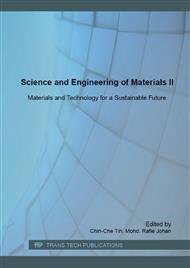[1]
K. Nakata and A. Fujishima, TiO2 photocatalysis: design and applications, J. Photochem. and Photobio. C: Photochem. Reviews 13 (3), (2012) 169-189.
Google Scholar
[2]
P. Roy, S. Berger and P. Schmuki, TiO2 nanotubes: synthesis and applications, Angew. Chem. Int. Ed. 50 (2011) 2904-2939.
DOI: 10.1002/anie.201001374
Google Scholar
[3]
J. Macak, H. Tsuchiya, A. Ghicov, K. Yasuda, R. Hahn, S. Bauer and P. Schmuki, TiO2 nanotubes: self-organized electrochemical formation, properties and applications, Current Opinion in Solid State and Mater. Sci. 11 (1), (2007) 3-18.
DOI: 10.1016/j.cossms.2007.08.004
Google Scholar
[4]
C. A. Grimes and G. K. Mor, TiO2 nanotube arrays: synthesis, properties, and applications, Springer Sci. & Bus. Media, New York, (2009).
Google Scholar
[5]
Berger, S., et al., Influence of water content on the growth of anodic TiO2 nanotubes in fluoride-containing ethylene glycol electrolytes. J. Electrochem. Soc., 157 (2010) C18-C23.
DOI: 10.1149/1.3251338
Google Scholar
[6]
D. Regonini, C. Bowen, A. Jaroenworaluck and R. Stevens, A review of growth mechanism, structure and crystallinity of anodized TiO2 nanotubes, Mater. Sci. and Eng.: R: Reports 74 (12), (2013) 377-406.
DOI: 10.1016/j.mser.2013.10.001
Google Scholar
[7]
Valota, A., et al., Influence of water content on nanotubular anodic titania formed in fluoride/glycerol electrolytes. Electrochimica Acta, 54 (2009) 4321-4327.
DOI: 10.1016/j.electacta.2009.02.098
Google Scholar
[8]
Z. Lockman, et al., Formation of Anodic Oxide Nanotubes in H2O2-Fluoride Ethylene Glycol Electrolyte as Template for Electrodeposition of α-Fe2O3. in Adv. Mater. Research. Vol. 832 (2014) 333-337.
Google Scholar
[9]
Z. Lockman, C.H. Kit, and S. Sreekantan, Effect of annealing temperature on the anatase and rutile TiO2 nanotubes formation. J. Nuclear and Related Technologies, Vol. 6, (2009) 57-64.
Google Scholar
[10]
Allam, N.K., K. Shankar, and C.A. Grimes, Photoelectrochemical and water photoelectrolysis properties of ordered TiO2 nanotubes fabricated by Ti anodization in fluoride-free HCl electrolytes. J. Mater. Chem., 18 (2008) 2341-2348.
DOI: 10.1039/b718580d
Google Scholar
[11]
I. Paramasivam, H. Jha, N. Liu and P. Schmuki, A review of photocatalysis using self-organized TiO2 nanotubes and other ordered oxide nanostructures, Small 8, (2012) 3073-3103.
DOI: 10.1002/smll.201200564
Google Scholar


